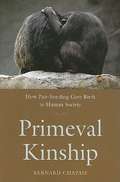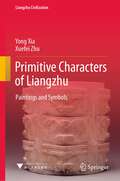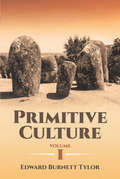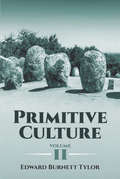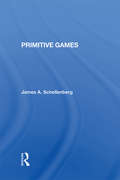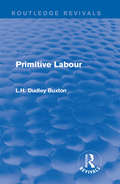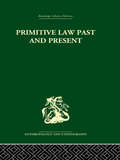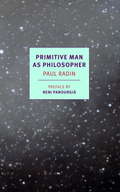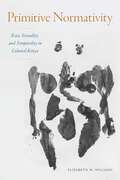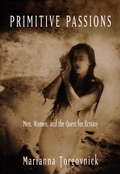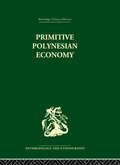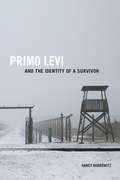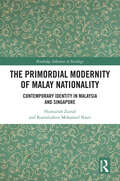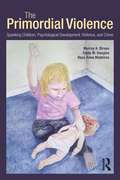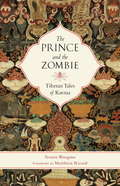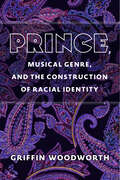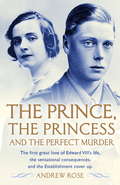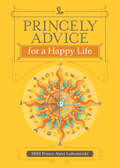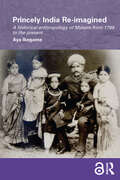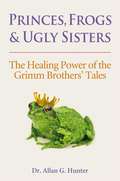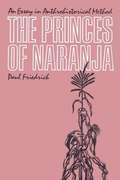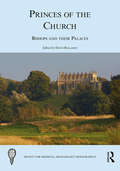- Table View
- List View
Primeval Kinship: How Pair-bonding Gave Birth To Human Society
by Bernard ChapaisIn this account of the dawn of human society, Bernard Chapais shows that our knowledge about kinship and society in nonhuman primates supports, and informs, ideas first put forward by the distinguished social anthropologist, Claude Levi-Strauss. Chapais contends that only a few evolutionary steps were required to bridge the gap between the kinship structures of our closest relatives-chimpanzees and bonobos-and the human kinship configuration. The pivotal event, the author proposes, was the evolution of sexual alliances. Pair-bonding transformed a social organization loosely based on kinship into one exhibiting the strong hold of kinship and affinity. The implication is that the gap between chimpanzee societies and pre-linguistic hominid societies is narrower than we might think. Primeval Kinship suggests that the study of kinship and social organization can provide a link between social and biological anthropology.
Primitive Characters of Liangzhu: Paintings and Symbols (Liangzhu Civilization)
by Yong Xia Xuefei ZhuThis book mainly focuses on the roles of engraved symbols and ornamentation in Liangzhu culture. It categorizes the engraved symbols discovered in Liangzhu culture as means of ideographical expression and decoration, aspects that are explored in detail. Further, the engraved symbols and ornamentation are subdivided in terms of certain similarities, including the dragon and bird systems. A separate chapter is especially designed to help readers appreciate the typical paintings and symbols in selected objects and vessels. In this way, the book seeks to analyze and generate a particular formula so as to explore patterns in the thinking of Liangzhu’s people, thus deciphering the spiritual code of the Liangzhu world.
Primitive Classification (Routledge Revivals: Emile Durkheim: Selected Writings in Social Theory)
by Emile Durkheim Marcel MaussIn this influential work, first published in English in 1963, Durkheim and Mauss claim that the individual mind is capable of classification and they seek the origin of the ‘classificatory function’ in society. On the basis of an intensive examination of forms and principles of symbolic classification reported from the Australian aborigines, the Zuñi and traditional China, they try to establish a formal correspondence between social and symbolic classification. From this they argue that the mode of classification is determined by the form of society and that the notions of space, time, hierarchy, number, class and other such cognitive categories are products of society. Dr Needham’s introduction assesses the validity of Durkhiem and Mauss’s argument, traces its continued influence in various disciplines, and indicates its analytical value for future researches in social anthropology.
Primitive Culture Volume I
by Edward Burnett TylorUse of the term "culture" as an expression of the full range of learned human behavior patterns began with this classic two-volume work, first published in 1871. Edward B. Tylor, the first Professor of Anthropology at the University of Oxford, declared that culture is "that complex whole which includes knowledge, belief, art, law, morals, custom, and any other capabilities and habits acquired by man as a member of society." Tylor is credited with the establishment of anthropology as a scientific discipline, and his groundbreaking work was highly influential in the development of cultural evolution as the foundation for anthropologic studies. Tylor's unilinear model of development maintains that humans share a common history, evolving from a single primitive form. His studies of the languages, rituals, and beliefs of societies from around the world pioneered the use of statistical data and substantiated his view of a universal pattern of development in all cultures. Volume I of Primitive Culture focuses on social evolution, language, and myth. Volume II focuses on Tylor's interpretation of animism in society, offering details of the endlessly varied ideas and beliefs regarding the soul, spirits, and gods.
Primitive Culture, Volume II: Researches Into The Development Of Mythology, Philosophy, Religion, Art, And Custom, Volume 2 - Primary Source Edition (Cambridge Library Collection - Anthropology)
by Edward Burnett TylorThe first Professor of Anthropology at the University of Oxford, Edward B. Tylor, defined the term "culture" for modern readers in this groundbreaking work. Initially published in 1871, this classic two-volume study explores the full range of learned human behavior patterns in terms of the beliefs, wisdom, laws, artistic achievements, and mores that constitute a society. The formation of anthropology as a scientific discipline began with this work, which continues to exercise a profound influence on anthropologic studies. The shared history of all humans, a common ground that evolved from primitive roots, constitutes the basis for Tylor's model of development. Drawing upon a worldwide variety of beliefs, rituals, and languages, the author illustrates an all-inclusive pattern of progress. His methods inaugurated the use of statistical data in anthropology, a standard procedure today but a landmark for his time. Volume I of Primitive Culture examines social evolution, language, and myth. The focus of this second volume is animism in society, which explores the tremendous diversity of thinking related to the concepts of the soul and religion as well as the marked similarities of spiritual beliefs.
Primitive Economics of the New Zealand Maori (Routledge Revivals)
by Raymond FirthFirst published in 1929, Raymond Firth’s original and insightful study offers an incredibly detailed account of the social and economic organisation of the Maori people before their contact with Western civilisation. Bridging the gap between anthropology and economics, the work covers the class structure, land system, industry, methods of co-operative labour, exchange and distribution, and the psychological foundations of Maori society. This reissue will be welcomed by all students of anthropology and anyone interested the history of the Maori people.
Primitive Games
by James A SchellenbergThis book shows how primitive games relate to the broader framework of the theory of games and provides a general discussion of the different types of primitive games. It deals with applications of primitive games to particular areas of social research.
Primitive Labour (Routledge Revivals)
by L.H. Dudley BuxtonOriginally published in 1924, Dudley Buxton explores the evolution of primitive societies in relation to labour. This is mostly done by studying primitive inventions to try and understand how each of these inventions was used to contribute to everyday living and to develop the society’s material culture. This study places an emphasis on understanding the importance of various industrial tools to societies in relation to different industries and geographical factors such as climate. This title will be of interest to students of Anthropology.
Primitive Law, Past and Present
by A.S. DiamondThis book is a study of the beginnings of law and the 'primitive' stages of its development, from the first rudimentary rules of conduct to the codes of the legal systems. Its scope extends to both cultures and legal systems from the ancient and medieval past: those of the Babylonians and Assyrians, Hittites, Hebrews, Romans, Hindus, English and other German peoples, and those of Africa, Australia and America. Correlating early economic and legal development, the book illustrates how laws change with the development of material culture. Originally published in 1971.
Primitive Man as Philosopher
by John Dewey Neni Panourgia Paul RadinAnthropology is a science whose most significant discoveries have come when it has taken its bearings from literature, and what makes Paul Radin’s Primitive Man as Philosopher a seminal piece of anthropological inquiry is that it is also a book of enduring wonder. Writing in the 1920s, when anthropology was still young, Radin set out to show that “primitive” cultures are as intellectually sophisticated and venturesome as any of their “civilized” counterparts. The basic questions about the structure of the natural world, the nature of right and wrong, and the meaning of life and death, as well as basic methods of considering the truth or falsehood of the answers those questions give rise to, are, Radin argues, recognizably consistent across the whole range of human societies. He rejects both the romantic myth of the noble savage and the rationalist dismissal of the primitive mind as essentially undeveloped, averring that the anthropologist and the anthropologist’s subject meet on the same philosophical ground, and only when that is acknowledged can anthropology begin in earnest. The argument is clearly and forcibly made in pages that also contain an extraordinary collection of poems, proverbs, myths, and tales from a host of different cultures, making Primitive Man as Philosopher not only a lasting contribution to the discipline of anthropology but a unique, rich, and fascinating anthology, one that both illuminates and enlarges our imagination of the human.
Primitive Normativity: Race, Sexuality, and Temporality in Colonial Kenya
by Elizabeth W. WilliamsIn Primitive Normativity Elizabeth W. Williams traces the genealogy of a distinct narrative about African sexuality that British colonial authorities in Kenya used to justify their control over indigenous populations. She identifies a discourse of “primitive normativity” that suggested that Africans were too close to nature to develop sexual neuroses and practices such as hysteria, homosexuality, and prostitution which supposedly were common among Europeans. Primitive normativity framed Kenyan African sexuality as less polluted than that of the more deviant populations of their colonizers. Williams shows that colonial officials and settlers used this narrative to further the goals of white supremacy by arguing that Africans’ sexuality was proof that Kenyan Africans must be protected from the forces of urbanization, Western-style education, and political participation, lest they be exposed to forms of civilized sexual deviance. Challenging the more familiar notion that Europeans universally viewed Africans as hypersexualized, Williams demonstrates how narratives of African sexual normativity rather than deviance reinforced ideas about the evolutionary backwardness of African peoples and their inability to govern themselves.
Primitive Passions
by Marianna TorgovnickBeginning with early 20th-century figures--among them Carl Jung, Isak Dinesen, and Georgia O'Keeffe--who found in "the primitive" a medium for soul-searching and personal change, Torgovnivk probes how the return to the primitive has signaled a quest to transcend the limitations of the body in a variety of contemporary practices, from genital piercing to New Age rites to the mythopoetic men's movement. Illustrations. 272 pp. Author tour. 10,000 print.
Primitive Polynesian Economy
by Raymond FirthA great classic of British anthropology, Primitive Polynesian Economy is structured as follows: · Problems of Primitive Economics · Food and Population in Tikopia · Knowledge, Technique and Economic Lore · The Labour Situation · Ritual in Productive Activity · Economic Functions of the Chiefs · Property and Capital in Production · Principles of Distribution and Payment · Exchange and Value · Characteristics of a Primitive Economy First published in 1939.
Primo Levi and the Identity of a Survivor
by Nancy HarrowitzPrimo Levi (1919–1987) was an Italian chemist, writer, and Holocaust survivor who used a combination of testimony, essays, and creative writing to explore crucial themes related to the Shoah. His voice is among the most important to emerge from this dark chapter in human history. In Primo Levi and the Identity of a Survivor, Nancy Harrowitz examines the complex role that Levi’s Jewish identity played in his choices of how to portray his survival, as well as in his exposition of topics such as bystander complicity. Her analysis uncovers a survivor’s shame that deeply influenced the personas he created to recount his experiences. Exploring a range of Levi’s works, including Survival at Auschwitz and lesser-known works of fiction and poetry, she illustrates key issues within his development as a writer. At the heart of Levi’s discourse, Harrowitz argues, lies a complex interplay of narrative modes that reveals his brilliance as a theorist of testimony.
The Primordial Modernity of Malay Nationality: Contemporary Identity in Malaysia and Singapore (Routledge Advances in Sociology)
by Humairah Zainal Kamaludeen Mohamed NasirHumairah and Kamaludeen examine contemporary Malay national identity in Singapore and Malaysia through the lens of ‘primordial modernity’, taking on a comparative transnational perspective. How do Malays in Singapore and Malaysia conceptualise and negotiate their ethnic identity vis-à-vis the state’s construction of Malay national identity? Humairah and Kamaludeen employ discourse analyses of both elite and mass texts that include newspaper editorials, school textbooks, political speeches, novels, movies, and letters in local newspapers. Extending current notions of Malay identity, the authors offer a comprehensive overview of Malay identity that takes into consideration both primordial dimensions and the more modern aspects such as their cosmopolitan sensibilities and their approach to social mobility. A valuable resource for scholars of Southeast Asian culture and society, as well as Sociologists looking at wider issues of ethnic and national identity.
The Primordial Violence: Spanking Children, Psychological Development, Violence, and Crime
by Emily M. Douglas Murray A. Straus Rose Anne MedeirosA CHOICE Outstanding Academic Title 2014! Why do parents hit those they love? What effect does it have on children? What can be done to end this pattern? These are some of the questions explored in The Primordial Violence. Featuring longitudinal data from over 7,000 U.S. families as well as results from a 32 nation study, the book presents the latest research on the extent to which spanking is used in different cultures and the subsequent effects of its use on children and on society. Evidence that shows the relationship between spanking and the subsequent slowing of cognitive development and increase in antisocial and criminal behavior is shown. Both cross-sectional and longitudinal studies are explored in an accessible fashion. An abundance of high quality research has produced findings that are highly consistent from study to study which show that spanking is a risk factor for aggressive behavior and other social and psychological problems. Because of these findings, the authors argue for policy changes and recommend a drastic reduction in the use of spanking. Policy and practical implications are explored in most chapters. The Primordial Violence highlights: The benefits of avoiding spanking such as the development of better interpersonal skills and higher academic achievement; The link between spanking and behavioral problems and crime; The extent to which spanking is declining and why despite the unusually high level of agreement between numerous studies which found harmful effects from spanking, most parents continue to spank. Part 1 documents the worldwide use of spanking and why parents spank. The possible adverse effects of spanking on children’s behavior and academic achievement, and the potential for violence and criminal behavior in later life, are explored in Parts 2, 3, and 4. Part 5 examines trends in spanking, and suggests what can be done to lower the percent of parents who spank. Contradictory opinions about whether to spank are explored. The book concludes with a call for change in this aspect of parenting which will have profound benefits, for the children and families involved, and society as a whole. Intended for a general audience of readers who are interested in child development and parenting and for advanced undergraduate and/or graduate courses in child abuse, family violence, juvenile delinquency, criminal behavior, social development, sociology of the family, or parenting and family relations taught in psychology, human development, family studies, criminology, education, social work, sociology, and social policy.
The Prince and the Zombie: Tibetan Tales of Karma
by Tenzin WangmoIn this series of tales, a prince must capture and bring back to his country a zombie who is endowed with magical powers--but in order to succeed he must keep himself from speaking even one word to the zombie. The zombie is wily, and during the long journey he recounts fascinating tales to the prince, who is carrying him in a sack on his back. Spellbound by the stories, the prince is drawn into making some comment on them. But the very moment he opens his mouth, the zombie escapes, and the prince has to go back to India to catch the zombie all over again. This same scenario occurs over and over, tale after tale, journey after journey--until the prince truly learns his lesson.These zombie stories, known as the Vetalapancavimsati in Sanskrit, are engrossing teaching tales that originated in ancient India but have become popular in the Buddhist culture of Tibet, as well as in other Asian cultures. This Tibetan version of the stories conveys the values of Buddhism, particularly those related to karma (the laws of cause and effect), happiness, and suffering. Through these tales, the reader learns that Buddhism is a path of knowledge that leads to liberation from suffering.
Prince, Musical Genre, and the Construction of Racial Identity (Tracking Pop)
by Griffin WoodworthThroughout his career, the Minneapolis musician Prince was known for fusing different musical genres as well as moving between different identities—sexual lothario, devout man of God, androgynous sprite—qualities that fit the postmodernism of the 1980s. This volume takes a fresh look at Prince’s work, arguing that his music was deeply informed by the history and techniques of Black culture, and that his multigenre fluency and changeable image were weapons that he deployed in a career-long fight against the racially segregated structures of the American music industry. Using a methodology that mixes musicology with African American literary theory, queer theory, and gender studies, this book analyzes the ways that Prince mixed and manipulated musical genres that are indexed to racial identities—such as “White” rock or new-wave, and “Black” funk, gospel, or R&B—in order to construct pluralistic identities. Each chapter includes detailed musical analyses and transcriptions of Prince’s songs, focusing on his use of rock guitar, new-wave synthesizers, funk drumming, gospel singing, and R&B horns. By tracking Prince’s transformations of instrumental and vocal idioms derived from specific musical genres, and considering the historical and cultural values embedded within those genres, Griffin Woodworth explores the ways that Prince musically broke down stereotypes of Black masculinity. With its intersectional approach to musical analysis, this book captures the sounds of American racial politics in the 1980s, 90s, and 2000s as heard through the music of one of the era’s most popular artists as he worked to transform and transcend those politics.
The Prince, the Princess and the Perfect Murder: An Untold History
by Andrew RoseThe royal family's darkest secret and the establishment cover-up. Half a century before Dodi and Diana, another Prince of Wales would be involved in a deadly love triangle with a fabulously wealthy Egyptian "prince." Prince Edward was the future King of England, a destiny he would famously forsake over his love for Wallis Simpson. But two decades prior he was involved in another love affair that threatened to jeopardize the royal family. The story took place in maisons de rendezvous, luxurious chateaux in the French countryside providing hospitality for the British upper classes, the richest food, the finest wines and the most beautiful women, the violent and dangerous Paris demi-monde - where many of the women came from - and the Savoy hotel in London, where a murder was committed. This major royal scandal, superbly covered up by the Royal family, the government and the judiciary has remained secret ever since.This is the story of a passionate and deadly love affair set against the dramatic backdrop of the Great War. Edward was enthralled by the 'crazy physical attraction' of Marguerite Alibert, queen of the Paris demi-monde. When he broke off their hidden relationship, Edward thought that he was free of Marguerite. He was wrong. After the war, as a violent thunderstorm raged outside the luxurious Savoy Hotel in London Marguerite fired three shots from a semi-automatic pistol. Her husband, and Egyptian multimillionaire and playboy, was shot dead at point blank range. Marguerite stood trial for murder at the Old Bailey. As Prince Charming and poster boy of the British Empire, Edward now risked exposure as a degenerate wastrel, partying behind the lines while thousands were blown away on the Western Front.Andrew Rose, using his long experience as a barrister and judge, has uncovered a royal scandal carefully airbrushed from history. Edward never quite escaped from Marguerite who had taught the arts of love to a once and future King.The Prince, the Princess and the Perfect Murder is the product of several years' research, accessing unpublished documents held in the Royal Archives and private collections in England and France.
The Prince, the Princess and the Perfect Murder: An Untold History
by Andrew RoseThe royal family's darkest secret and the establishment cover-up. Half a century before Dodi and Diana, another Prince of Wales would be involved in a deadly love triangle with a fabulously wealthy Egyptian "prince." Prince Edward was the future King of England, a destiny he would famously forsake over his love for Wallis Simpson. But two decades prior he was involved in another love affair that threatened to jeopardize the royal family. The story took place in maisons de rendezvous, luxurious chateaux in the French countryside providing hospitality for the British upper classes, the richest food, the finest wines and the most beautiful women, the violent and dangerous Paris demi-monde - where many of the women came from - and the Savoy hotel in London, where a murder was committed. This major royal scandal, superbly covered up by the Royal family, the government and the judiciary has remained secret ever since.This is the story of a passionate and deadly love affair set against the dramatic backdrop of the Great War. Edward was enthralled by the 'crazy physical attraction' of Marguerite Alibert, queen of the Paris demi-monde. When he broke off their hidden relationship, Edward thought that he was free of Marguerite. He was wrong. After the war, as a violent thunderstorm raged outside the luxurious Savoy Hotel in London Marguerite fired three shots from a semi-automatic pistol. Her husband, and Egyptian multimillionaire and playboy, was shot dead at point blank range. Marguerite stood trial for murder at the Old Bailey. As Prince Charming and poster boy of the British Empire, Edward now risked exposure as a degenerate wastrel, partying behind the lines while thousands were blown away on the Western Front.Andrew Rose, using his long experience as a barrister and judge, has uncovered a royal scandal carefully airbrushed from history. Edward never quite escaped from Marguerite who had taught the arts of love to a once and future King.The Prince, the Princess and the Perfect Murder is the product of several years' research, accessing unpublished documents held in the Royal Archives and private collections in England and France.
Princely Advice for a Happy Life
by Alexi LubomirskiA royal prince and father offers wisdom on cultivating virtue in this “keepsake for a lifetime and for many generations to follow.” (Vanity Fair)Princely Advice for a Happy Life is a thoughtful collection of heartfelt advice from a father (who happens to be a prince!) to his beloved sons. HSH (His Serene Highness) Prince Alexi Lubomirski's sublime guidance resonates with anyone who desires to live a noble, meaningful life. Destined to be a treasured family keepsake, this book is truly for everyone. Mixing old-world charm with modern-day spirituality HSH Prince Alexi Lubomirski advises on all aspects of life from romance to spirituality, manners to chivalry, love, balance, and leadership. Eloquent, timeless counsel for living a gracious life and cultivating inner nobility, Princely Advice for a Happy Life is the perfect gift to give for graduation, a milestone birthday, or any occasion.“This book is a must-read for anyone who loves Princes or aspires to be one. Alexi Lubomirski is truly a modern incarnation of Prince Charming.” —Paper magazine“ . . . many people, no matter their age, could benefit from reading.” —The New York Times T magazine“ . . . thanks to Alexi Lubomirski, we can all rest a little easier. The fashion photographer has penned a book to teach us all how to be a little more prince/princess-like . . . adorably written . . . “ —Elle“Chivalry is not dead; it lives in a little, yellow book, Princely Advice for a Happy Life, and author and photographer Alexi Lubomirski is quite possibly its ultimate personification.” —Harper's Bazaar
Princely India Re-imagined: A Historical Anthropology of Mysore from 1799 to the present (Routledge/Edinburgh South Asian Studies Series)
by Aya IkegameIndia’s Princely States covered nearly 40 per cent of the Indian subcontinent at the time of Indian independence, and they collapsed after the departure of the British. This book provides a chronological analysis of the Princely State in colonial times and its post-colonial legacies. Focusing on one of the largest and most important of these states, the Princely State of Mysore, it offers a novel interpretation and thorough investigation of the relationship of king and subject in South Asia. The book argues that the denial of political and economic power to the king, especially after 1831 when direct British control was imposed over the state administration in Mysore, was paralleled by a counter-balancing multiplication of kingly ritual, rites, and social duties. The book looks at how, at the very time when kingly authority was lacking income and powers of patronage, its local sources of power and social roots were being reinforced and rebuilt in a variety of ways. Using a combination of historical and anthropological methodologies, and based upon substantial archival and field research, the book argues that the idea of kingship lived on in South India and continues to play a vital and important role in contemporary South Indian social and political life. The Open Access version of this book, available at http://www.taylorfrancis.com, has been made available under a Creative Commons Attribution-Non Commercial-No Derivatives 4.0 license.
Princes, Frogs and Ugly Sisters
by Dr Allan HunterAnalyzing the ways in which the Grimm brothers' tales provide real, vital insights into how to live more happily, understand the need for personal and psychological growth, and find that significant other, this innovative study revives the true healing nature of these beloved tales. Combining enjoyment of these tales with insightful research, this exploration uses actual case histories to show how the odd and bizarre episodes in fairy tales are actually astounding renditions of human behaviors that occur during times of crisis. It also shows how the six archetypal stages of psychological development are present both in these tales and in everyday life. Contrary to common, contemporary fairy tale re-creations, this study discusses how the Grimm brothers' stories deal with topics such as dysfunctional family dynamics, sexual jealousy, narcissism, incest, rape, and personal growth from trauma to wellness-noting that Cinderella didn't have a fairy godmother and frogs were never kissed.
The Princes of Naranja: An Essay in Anthrohistorical Method
by Paul FriedrichIn this groundbreaking study, Paul Friedrich looks closely at the strong men of the Tarascan Indian village of Naranja: their leadership, friendship, kinship, and violent local politics (over a time depth of one generation), and ways to understand such phenomena. What emerges is an acutely observed portrait of the men who form the very basis of the grass-roots power structure in Mexico today. Of interest to historians, sociologists, and political scientists, as well as Latin Americanists and anthropologists, The Princes of Naranja is a sequel to Friedrich's now classic Agrarian Revolt in a Mexican Village. It begins with biographical character studies of seven leaders-peasant gunmen, judges, politicos; here the book will grip the reader and provoke strong emotional response, from laughter to horror. A middle section places these "princes" in relation to each other, and to the contexts of village society and the larger entities of which it forms a part. Friedrich's synthesis of anthropology, local (mainly oral) history, macrohistory, microsociology, psychology, and literature gives new insight into the structure of Mexican politics from the local level up, and provides a model for other scholars doing analogous work in other parts of the world, especially in the developing world. The concluding section raises vital questions about the dynamic relations between the fieldworker, fieldwork, field notes, the villagers, the writing of a fieldwork-based book, and, implicitly, the audience for such books.
Princes of the Church: Bishops and their Palaces (Society for Medieval Archaeology Monographs)
by David RollasonPrinces of the Church brings together the latest research exploring the importance of bishops’ palaces for social and political history, landscape history, architectural history and archaeology. It is the first book-length study of such sites since Michael Thompson’s Medieval Bishops’ Houses (1998), and the first work ever to adopt such a wide-ranging approach to them in terms of themes and geographical and chronological range. Including contributions from the late Antique period through to the eighteenth and nineteenth centuries, it deals with bishops’ residences in England, Scotland, Wales, the Byzantine Empire, France, and Italy. It is structured in three sections: design and function, which considers how bishops’ palaces and houses differed from the palaces and houses of secular magnates, in their layout, design, furnishings, and functions; landscape and urban context, which considers the relationship between bishops’ palaces and houses and their political and cultural context, the landscapes and towns or cities in which they were set, and the parks, forests, and towns that were planned and designed around them; and architectural form, which considers the extent of shared features between bishops’ palaces and houses, and their relationship to the houses of other Church potentates and to the houses of secular magnates.
